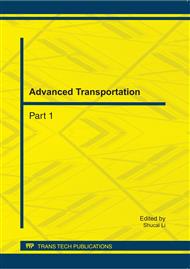p.892
p.896
p.903
p.907
p.911
p.919
p.925
p.931
p.935
Bus Scheduling Model for Adjustment Headway of Bus Carriers
Abstract:
Nowadays, the total volume of passenger trip demand has increased due to population and economic growth. In this situation , government policy encourages people to use public transportation for inter-city trips. In the meantime, buses are the most widely used in transit technology today. The most important issue in buses service is timely arrival. Due to the limited capacity of the streets and increasing car production, we cannot devote a specific lane to bus operation to separate their operation from other traffic. Generally, actual arrival time of buses in comparison to planned arrival time occurs in three scenarios : sooner, on-time, and later. This article represents different scheduling model to achieve timely arrival. For this purpose we tested two different scenarios by actual public bus operation. The data was obtained in the city of Tehran, since Iran was used in this study.
Info:
Periodical:
Pages:
911-915
Citation:
Online since:
September 2011
Authors:
Keywords:
Price:
Сopyright:
© 2011 Trans Tech Publications Ltd. All Rights Reserved
Share:
Citation:


